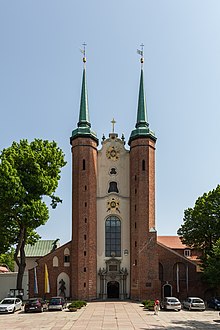Oliwa Cathedral
| Archcathedral Basilica of The Holy Trinity, Blessed Virgin Mary and St Bernard in Gdańsk Oliwa | |
|---|---|
 |
|
| Basic information | |
| Location | Gdańsk Oliwa |
| Affiliation | Roman Catholic |
| State | Poland |
| Year consecrated | 14 August 1594 |
| Ecclesiastical or organizational status | Minor basilica, archcathedral |
| Status | active |
| Materials | Brick |
Gdańsk Oliwa Archcathedral is a church located in Gdańsk, Oliwa district; dedicated to The Holy Trinity, Blessed Virgin Mary and St Bernard.
The archcathedral in Oliwa is a three-nave basilica with a transept and a multisided closed presbytery, finished with an ambulatory. The façade is flanked by two slender towers, 46-metres tall each with sharply-edged helmets. It is enlivened by a Baroque portal from 1688, as well as three windows of different sizes and three cartouches. The crossing of the naves is overlooked by a bell tower, a typical element of the Cistercian architecture. The cathedral is 17.7m high, 19m wide and 107m long (97.6m of the interior itself), which makes it the longest Cistercian church in the world. It holds works of art in Renaissance, Baroque, Rococo and Classical style of great artistic value.
All the 23 altars of the cathedral are of great historical value. They are mainly Baroque and Rococo, partly made of marble. Their iconography depicts the main principles of the post-Trent church. Most outstanding are the present High Altar (1688), which is the most profound Baroque work of art in Pomerania; and the Netherland Renaissance style altar, which until 1688 played the role of the main one. The paintings in the altars, presbytery and main nave were made by the famous 17th- century artists: Herman Han (1574–1628), Adolf Boy (1612-1680), Andrzej Stech (1635–1697) and Andreas Schlütera (1660–1714). The interior also holds Rococo chapels of the Holy Cross and St John of Nepomuk, an ambo, tombstones, epitaphs, the Pomeranian Dukes tomb, the Kos family tomb, bishop’s crypt, antique chandeliers, canopies, and many other antiquities, including a feretory of great cultural value, showing Our Lady of Oliwa with an Infant Jesus. The feretory is always carried during the annual walking pilgrimage to the Calvary of Wejherowo. The archcathedral holds organ concerts all year round and the beautifully restored monastery (now belonging to Gdańsk Seminary) displays the collection of the Diocesan Museum. Oliwa Cathedral is very important place for the Kashubian culture.
...
Wikipedia
